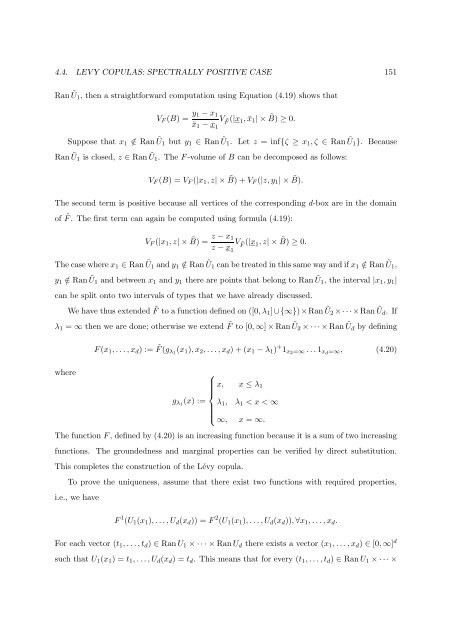Processus de Lévy en Finance - Laboratoire de Probabilités et ...
Processus de Lévy en Finance - Laboratoire de Probabilités et ...
Processus de Lévy en Finance - Laboratoire de Probabilités et ...
You also want an ePaper? Increase the reach of your titles
YUMPU automatically turns print PDFs into web optimized ePapers that Google loves.
4.4. LEVY COPULAS: SPECTRALLY POSITIVE CASE 151<br />
Ran Ũ1, th<strong>en</strong> a straightforward computation using Equation (4.19) shows that<br />
Suppose that x 1<br />
V F (B) = y 1 − x 1<br />
¯x 1 − x 1<br />
V ˜F<br />
(|x 1 , ¯x 1 | × ˜B) ≥ 0.<br />
/∈ Ran Ũ1 but y 1 ∈ Ran Ũ1. L<strong>et</strong> z = inf{ζ ≥ x 1 , ζ ∈ Ran Ũ1}. Because<br />
Ran Ũ1 is closed, z ∈ Ran Ũ1. The F -volume of B can be <strong>de</strong>composed as follows:<br />
V F (B) = V F (|x 1 , z| × ˜B) + V F (|z, y 1 | × ˜B).<br />
The second term is positive because all vertices of the corresponding d-box are in the domain<br />
of ˜F . The first term can again be computed using formula (4.19):<br />
V F (|x 1 , z| × ˜B) = z − x 1<br />
z − x 1<br />
V ˜F<br />
(|x 1 , z| × ˜B) ≥ 0.<br />
The case where x 1 ∈ Ran Ũ1 and y 1 /∈ Ran Ũ1 can be treated in this same way and if x 1 /∈ Ran Ũ1,<br />
y 1 /∈ Ran Ũ1 and b<strong>et</strong>we<strong>en</strong> x 1 and y 1 there are points that belong to Ran Ũ1, the interval |x 1 , y 1 |<br />
can be split onto two intervals of types that we have already discussed.<br />
We have thus ext<strong>en</strong><strong>de</strong>d ˜F to a function <strong>de</strong>fined on ([0, λ 1 ]∪{∞})×Ran Ũ2 ×· · ·×Ran Ũd. If<br />
λ 1 = ∞ th<strong>en</strong> we are done; otherwise we ext<strong>en</strong>d ˜F to [0, ∞] × Ran Ũ2 × · · · × Ran Ũd by <strong>de</strong>fining<br />
F (x 1 , . . . , x d ) := ˜F (g λ1 (x 1 ), x 2 , . . . , x d ) + (x 1 − λ 1 ) + 1 x2 =∞ . . . 1 xd =∞, (4.20)<br />
where<br />
⎧<br />
x, x ≤ λ 1<br />
⎪⎨<br />
g λ1 (x) := λ 1 , λ 1 < x < ∞<br />
⎪⎩<br />
∞, x = ∞.<br />
The function F , <strong>de</strong>fined by (4.20) is an increasing function because it is a sum of two increasing<br />
functions. The groun<strong>de</strong>dness and marginal properties can be verified by direct substitution.<br />
This compl<strong>et</strong>es the construction of the Lévy copula.<br />
To prove the uniqu<strong>en</strong>ess, assume that there exist two functions with required properties,<br />
i.e., we have<br />
F 1 (U 1 (x 1 ), . . . , U d (x d )) = F 2 (U 1 (x 1 ), . . . , U d (x d )), ∀x 1 , . . . , x d .<br />
For each vector (t 1 , . . . , t d ) ∈ Ran U 1 × · · · × Ran U d there exists a vector (x 1 , . . . , x d ) ∈ [0, ∞] d<br />
such that U 1 (x 1 ) = t 1 , . . . , U d (x d ) = t d . This means that for every (t 1 , . . . , t d ) ∈ Ran U 1 × · · · ×
















